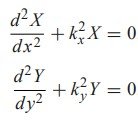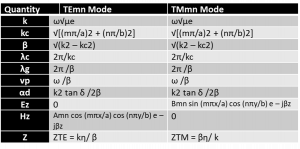Points of Discussion
Introduction to rectangular waveguide
Rectangular Waveguides are one of the primarily used transmission lines. The primary application of rectangular waveguides was the transmission of microwave signals. It has still some critical applications. Some of the components like – couplers, detectors, isolators, attenuators, and slotted lines are available in the market with their large variety for different waveguides band ranging from 1 to 22o GHz. Nowadays, modern devices are using planar transmission lines like stripline or microstrips rather than waveguides. It also helps the miniaturization of the devices. However, the waveguides still have significant applications, including high-power systems, millimetre wave applications, satellite systems, etc.
Rectangular waveguides of a hollow structure can propagate TE (transverse electrical) modes and TM (transverse magnetic) modes but not the TEM (transverse electromagnetic) modes. The reason behind such characteristics is the single conductor. This article will discuss the transmission of TE and TM modes and find out several properties of them.
Know about Transmission Lines and waveguides. Click Here!
TE Modes on Rectangular Waveguide
As we know, TE modes of waveguides are specified by Ez = 0 and hz will satisfy the reduced wave equation. The reduced wave equation is given below.

Here, the cut off number is the kc. It is given as: kc = √ (k2 − β2) and Hz (x, y, z) = hz (x,y) e – jβz.
Now, the above equation can be solved using the method of separation of variables. Let, hz (x,y) = X (x) Y(y)
Substituting the hz in the equation, we get:

Following the usual separation of variables, as each of the terms must be equal to a constant, we provide separation constant kx and ky. Now, the equations are:

The constants also satisfy another condition. That is: kx2 + ky2 = kc2
The typical solution for hz comes as:
hz (x, y) = (A coskxx +B sinkxx) (C coskyy + D sinkyy).
To determine the constant value, boundary conditions have to apply on the electric field components in tangential direction to the waveguide’s wall. They are given below.
ex (x, y) = 0 for y= 0 and b.
ey (x, y) = 0 for x= 0 and a.
The values of ex and ey from hz comes as below. They are calculated from some other wave equations.

From the boundary conditions of ex and evaluated value of ex, D’s value comes as 0 and ky = nπ/b for n = 0, 1, 2…
Also, from the boundary conditions of ey and evaluated value of ey, B’s value comes as 0 and kx = mπ/a for m = 0, 1, 2…
At last, the solution of Hz comes as:
Hz (x, y, z) = Amn cos (mπx/a) cos (nπy/b) e – jβz
Here, Amn is an arbitrary amplitude constant which is made up of the constants A and C.
Now, the transverse field components of TEmn modes are specified below.

The propagation constant is given by:
β = (k2 – kc2)1/2 = (k2 – (mπ/a)2 – (nπ/b)2)1/2
Now, in reality, k > kc,
β = [(mπ/a)2 + (nπ/b)2]1/2
Now each mode (for each combination of m and n) has a cutoff frequency. It is specified by fcmn.
fcmn = kc/ (2π√µe) = (1/(2π√µe) * [(mπ/a)2 + (nπ/b)2]1/2
The mode having the lowest cutoff frequency is known as dominant mode. In the dominant mode, we assume that a > b. the minimum cut off frequency happens for the TE10 mode and cutoff freq. expressed as:
fc10 = 1 / (2aõe)
TE10 is the overall dominant mode for TE mode. Now for m = n = 0, all the expression comes to 0. That is why there is no TE00 mode.
The wave impedance with the relation of the transverse magnetic field and transverse electric field comes as ZTE = Ex / Hy = Ey / Hx = kη / β
Here, η = √µ/e. It is the intrinsic impedance of the material present inside the waveguide.
There is another important parameter present known as guide wavelength. It is defined as the difference between two equal-phase along the waveguide. The difference here means the distance. Guide Wavelength can be calculated as
λg = 2π / β > 2π / k = λ
Wherever, λ is the wavelength of a plane wave which is present in between the guide.
The following expression gives the phase velocity.
υp = ω / β > ω / k = 1 / (√µe)
It is greater than the speed of light.
Know about 7+ Applications of Microwave Engineering and Overview. Click Here!
TM Modes on Rectangular waveguide
We know that TM modes are characterized by Hz = 0. And the Ez component must satisfy the reduced wave equation.

Here, Ez (x, y, z) = ez (x, y) e -jβz. Here, the cut off number is the kc. It is given as kc = √ (k2 − β2).
The solution is achieved using the same process as that of TE mode. The typical solution of ez comes as:
ez (x, y) = (A coskxx +B sinkxx) (C coskyy + D sinkyy)
Now, applying the bounding conditions, which are listed below, we get –
ez (x, y) = 0 for x= o and x = a,
and, ez (x, y) = 0 for y = 0 and y = b.
Now, from the boundary conditions of ez and evaluated value of ez, the value of A comes as 0 and kx = mπ/a for m = 0, 1, 2…
Also. from the boundary conditions of ez and evaluated value of ez, the value of C comes as 0 and ky = nπ/b for n = 0, 1, 2…
At last, the solution of Ez comes as:
Ez (x, y, z) = Bmn sin (mπx/a) cos (nπy/b) e – jβz
Here, Bmn is an arbitrary amplitude constant which is made up of the constants B and D.
The calculated transverse components for the TMmn modes are listed below.

The propagation constant is given by:
β = (k2 – kc2)1/2 = (k2 – (mπ/a)2 – (nπ/b)2)1/2
For TM modes, the dominant mode is TM11 as the other lower mode like TM00, TM01 or TM10 is not possible as the filed expressions become zero. The cutoff frequency for the dominant mode is given as: fcmn.
fc11 = (1/(2π√µe) * [(mπ/a)2 + (nπ/b)2]1/2
The wave impedance with the relation of transverse magnetic field and transverse electric field, comes as: ZTM = Ex / Hy = – Ey / Hx = ηβ / k
Solved Example on Rectangular Waveguide
1. A rectangular waveguide is filled up with Teflon, and it is copper K-band. The value of a = 1.07 cm and b = 0.43 cm. The operating frequency is 15 GHz. Answer the following queries.
A. Calculate the cut-off frequencies for the first five propagating nodes.
B. compute the attenuation because of dielectric and conductor loss.
Solution:
The permeability of Teflon is 2.08. tan delta = 0.0004
We know that the cutoff frequencies are:
fcmn = (c/(2π√µe) * [(mπ/a)2 + (nπ/b)2]1/2
Now, the values for different m and n values are calculated using the formula.
The below list shows the values.

The first five modes those will propagate through the rectangular waveguide are TE10, TE20, TE01, TE11 and TM 11.
At 15 GHz, k = 453.1 m-1.
The propagation constant for TE10 comes as:
β = [ (2πf√er/c)2 – (π/a)2] ½ = [k2 – (π/a)2]1/2 = 345.1 m-1
The attenuation from dielectric loss: αd = k2 tan δ / 2β = 0.119 Np/m
Or, αd =1.03 dB/m.
The surface resistivity of the copper (conductivity is 5.8 x 107 S/m) walls are:
Rs = √(ωµ0/2σ) = 0.032 ohm.
The attenuation from the conductor loss:
αc = (Rs / a3bβkη) * (2bπ2 + a3k2) = 0.050 Np/m = 0.434 dB/m.
Characteristic Table of Rectangular Waveguide

Cover GIF by: L’OFFICIEL MARTINIQUE

Hi, I am Sudipta Roy. I have done B. Tech in Electronics. I am an electronics enthusiast and am currently devoted to the field of Electronics and Communications. I have a keen interest in exploring modern technologies such as AI & Machine Learning. My writings are devoted to providing accurate and updated data to all learners. Helping someone in gaining knowledge gives me immense pleasure.
Let’s connect through LinkedIn –